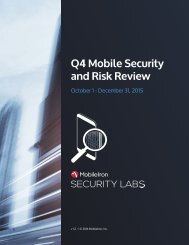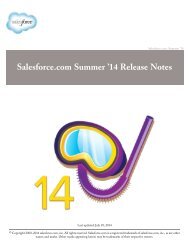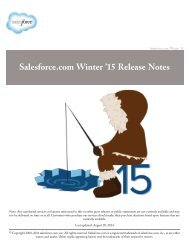SOA Magazine IV 01.2015
SOA Magazine IV 01.2015
SOA Magazine IV 01.2015
You also want an ePaper? Increase the reach of your titles
YUMPU automatically turns print PDFs into web optimized ePapers that Google loves.
As time went by, a combination of market pressure and industry trends, caused Oracle to<br />
include in the 10g release of <strong>SOA</strong> Suite (year 2007) something called: Oracle Enterprise Service<br />
Bus (OESB). Then Oracle could finally say: we do have as part of our stack an Enterprise Service<br />
Bus.<br />
As fancy as it sounded, this former version of Oracle’s ESB was somehow limited and never<br />
really qualified as a best-of-breed product. Furthermore, it never boded well with architects,<br />
developers and administrators who found it a tad complicated and unfriendly.<br />
So, it seems like we’ve identified a first milestone in this BPEL vs OSB discussion. An early<br />
version of the <strong>SOA</strong> Suite we’ve come to know (10g), which included:<br />
An already robust and highly-liked product based on an up and coming industry<br />
standard (BPEL)<br />
A below average ESB as an optional component of the suite<br />
At the time, Oracle ESB (OESB) wound up not being heavily used in most integration projects<br />
outside of AIA implementations. For the time being and the state of industry requirements,<br />
BPEL could exist and function mostly by its own.<br />
Then in 2008, Oracle buys BEA Systems, and with this acquisition we come into a second<br />
relevant milestone: The release of Oracle <strong>SOA</strong> Suite 11g in mid-2009. This new and revamped<br />
stack introduced some very relevant changes:<br />
1. Oracle WebLogic Server as the runtime platform for all of the tools included in the Suite.<br />
2. Oracle Service Bus (based on the former BEA AquaLogic Service Bus) comes along, as a<br />
true ESB capable of positioning itself as one of the market-leading players.<br />
3. 10g’s ESB (OESB), is rebranded as “Mediator” and stays as an optional component of the<br />
Suite.<br />
This proved to be a great move by Oracle, and from the technology/architecture standpoint it<br />
gave to the components its specific weight. Now the Enterprise Service Bus<br />
standards/capabilities were very well identified inside Oracle Service Bus. But if your <strong>SOA</strong><br />
initiative included orchestration, business activity monitoring, business rules, the Oracle <strong>SOA</strong><br />
Suite with the rest of the components, was an excellent option.<br />
With this new stack, OSB could even be licensed on its own for clients that wanted to have the<br />
ESB alone as a cornerstone for their <strong>SOA</strong> implementation, though the most usual scenario is for<br />
the customers to have both the <strong>SOA</strong> Suite and the OSB as part of a multifaceted and well<br />
complimented <strong>SOA</strong> Toolkit.<br />
Copyright © 2015 | All Rights Reserved <strong>SOA</strong> <strong>Magazine</strong> <strong>IV</strong> 5






